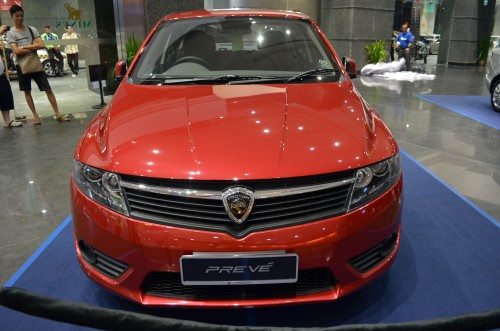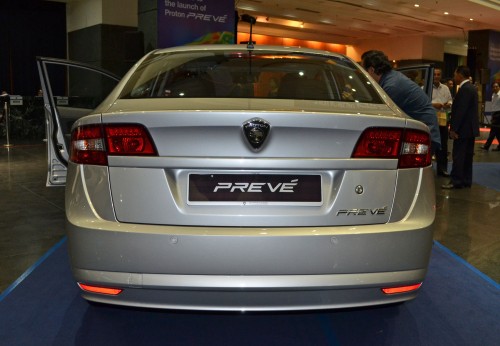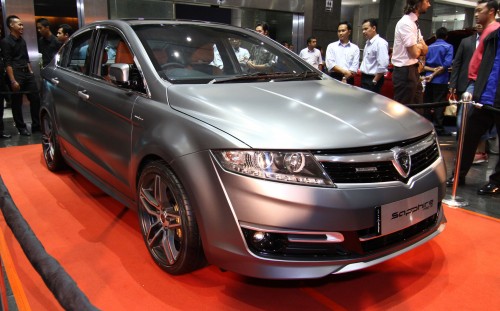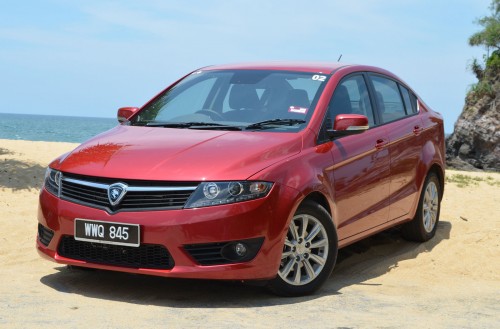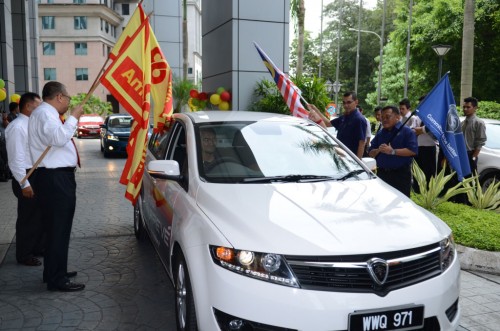Thursday, May 31, 2012
Proton Inspira
Handling
Much of the work Proton did was concentrated on improving the 2012 Proton Inspira's ride-and-handling. Even so, Mitsubishi limited the scope of changes: Proton was allowed to choose the tyre supplier (tyre size still 205/60 R16), use different shock absorbers, increase the size of the front/rear stabiliser bars, and tune the stabiliser bar and damper settings. The end result, Proton says, is a car that rolls less through corners and is more predictable at the limit compared with the Mitsubishi Lancer. On the move, the 2012 Proton Inspira is indeed less twitchy, containing body roll well, gripping on strongly and feeling very composed even when pushed hard. The steering is accurate though short on feedback and heft. While not as sporty to handle as the Proton Waja, the car it replaces, the 2012 Proton Inspira provides a better balance between handling prowess and ride comfort.
Comfort
The ride comfort is excellent, as road irregularities and undulating surfaces are nicely isolated. Cabin refinement is much better than any Proton's, but still some way short of a Toyota's, with engine drone at higher revs the biggest issue. The carried-over interior, dominated by a simple dash design, offers good ergonomics with controls and instrumentation that are intuitively positioned, easy-to-use and plain-in-sight. The seats are supportive, while the driver's seat adjusts for height. The steering, however, does not adjust for reach, which could pose a problem for certain drivers.
Quality + Reliability
Proton claims to have found better methods of manufacturing the interior panels, and that the 2012 Proton Inspira is equipped with a higher-quality interior than the Mitsubishi Lancer as a result. While we cannot be certain of that, the Proton Inspira is much better-built inside than any Proton is, and that will probably remain true for years to come. Quality plastics are used for high-contact areas, the fit-and-finish are completed to Mitsubishi standards, and the switchgear feels tactile to operate. What's not to like? The engines and transmissions have been proven reliable in the Lancer, and should remain so in the 2012 Proton Inspira.
Performance
Carried over unchanged from Mitsubishi, the 150 hp, 197 Nm 2.0-litre engine offers a strong on-road performance that never leaves you wishing for more power. Likewise, the 140 hp, 177 Nm 1.8-litre engine churns out enough oomph for your daily overtaking and highway cruising. Both engines prove willing to rev, hitting their peak power at 6000 rpm and peak torque at 4250 rpm. However, the 1.8-litre's engine note becomes especially loud and unpleasant at high revs—a situation made worse by the CVT. Keen drivers will find the CVT's six virtual ratios very handy, though those yearning for mechanical interaction will find pleasure in the five-speed manual gearbox (only with the 1.8-litre), which features a light clutch and feels precise to shift.
Roominess
Like in the Mitsubishi Lancer, the 2012 Proton Inspira is never lacking in space whether up front, at the back or in the boot. The driver and front passenger have plenty of room at their disposal, along with excellent support from the front seats. Those behind should not have too much to complain about, either, with no lack of leg- or head-room. Shoulder room is compromised with three passengers at the back, and the rear seating bench is not as comfortable as the front seats—though both remain true for rivals. The 400-litre boot can be expanded using the 60:40 split-fold rear seatbacks if required.
Running Costs
The 1.8 manual, 1.8 CVT and 2.0 CVT variants return fuel economy of 15.9 km/litre, 16.1 km/litre and 15.9 km/litre, respectively. All figures are highly impressive for a mid-size car, except that these figures, supplied by Proton, are only achievable when travelling at a constant speed of 90 km/h; frequent stop-start driving, common in an urban environment, would be much less economical. Car maintenance and servicing costs should be affordable, even in the longer term considering the car's proven reliability. Despite the Proton badge, the Inspira should hold on to its value relatively well compared with other Proton models. One would expect the trusted Mitsubishi underpinnings rather than the less desirable Proton reputation to dictate the Inspira's value in the resale market; only time will tell, however.
Value for Money
Born out of a technical agreement with Mitsubishi, the 2012 Proton Inspira is almost exactly the same as the Mitsubishi Lancer, except for some visual differentiation and suspension tweaking. The fact is that, with such a good base to work upon, Proton simply cannot go wrong with the Inspira, which exhibits traits like good looks, excellent ride-and-handling, and refinement and quality that are years ahead on any Proton. The 2012 Proton Inspira is easily the best local model to date, and, when you consider the value-for-money proposition, it is clearly the best car in the sub-RM 100K segment.
Equipment
Standard items include 16" alloy wheels, front fog lamps, “Welcome Home” and “Coming Home” light system, auto-off lights, keyless entry, power-adjustable side mirrors, reverse sensors, trunk lid remote release, leather steering wheel with audio controls, and Arkamys audio system with CD-player, MP3-compatibility and Bluetooth-connectivity. Safety features comprise dual front SRS airbags, front seatbelt pretensioners, ISOFIX points, and ABS with EBD. The Premium variant adds on a body kit complete with rear spoiler, paddle shifters, automatic headlights, automatic wipers, automatic climate control, leather upholstery, GPS navigation system, and auto cruise function controllable via steering wheel switches.
Environment
Proton has not supplied figures for the Inspira, but Mitsubishi has listed the fuel economy and carbon emissions of comparable Lancer variants: the 1.8 manual variant emits 183 grams/km and consumes 13.0 km/litre; the 1.8 CVT variant with 188 grams/km and 12.7 km/litre; and the 2.0 CVT variant with 196 grams/km and 12.2 km/litre. These figures are about average in the mid-size sedan segment. With no changes to the powertrain, it is fair to assume the same set of data for the 2012 Proton Inspira.
Friday, May 4, 2012
PROTON PREVE
The Prevé is offered in three variants, each with its unique engine/transmission combo. The two Executive variants are powered by Proton's venerable 1,597cc Campro IAFM+ engine with the choice between a Getrag 5-speed manual transmission and a Punch CVT with six virtual ratios.
Top of the line is the Premium model powered by the turbocharged Campro CFE engine paired exclusively to a more elaborate CVT also from Punch, but featuring seven virtual ratios and paddle shifters for manual overriding. Early booking numbers from Proton show that majority of orders have been for this variant.
Both engines powering the Prevé are already familiar hardware in Proton cars before its launch. The Executive model's Campro IAFM+ engine has been in service since the Persona was launched, and its outputs of 108hp @ 5,750rpm and 150Nm @ 4,000rpm are identical to the Saga FLX SE, which also shares its CVT2 transmission.
Meanwhile, the more advanced Campro CFE engine, which displaces 1,561cc due to a shorter cylinder stroke, is the same one that debuted in the Exora. It makes 138hp @ 5,000rpm and 205Nm @ 2,000 - 4,000rpm. Its CVT however, is a little more advanced than the Exora's although the basic hardware is identical.
The Prevé is developed on the Exora's platform, but with a new rear subframe that incorporates independent multi-link suspension. Front wheels are suspended by MacPherson struts, and Proton is sticking with hydraulic power steering despite current trends favouring electric assist. No complaints from an enthusiast's point of view. All-round disc brakes are standard.
Safety equipment of all three variants are relatively on par. Although the IAFM models have to make do without traction control, stability control, and side airbags, they still get ABS, EBD, dual airbags, front active head rest, and anti-pinch driver power window. What's a little shocking however, is that ISOFIX child mounts are offered only in the CFE model.
Other spec differentiations include auto air-con, push start button, cruise control, rain sensors, auto headlights, and auto folding side mirrors, all items exclusive to the CFE. Creature comforts that the IAFM models do get are steering-mounted controls, remote boot release, and in-car WIFI. On-board audio features MP3 playback, Bluetooth, USB, and iPod connectivity. The CFE model also gets a built-in GPS.
Available in six colour choices: Blue Lagoon, Fire Red, Tranquility Black, Solid White, Genetic Silver and Elegant Brown, the Prevé can be test driven at all Proton authorized showrooms nationwide. The Prevé is priced from RM72,990 on-the-road (Peninsular Malaysia) for the CFE variant, RM62,990 for the IAFM CVT and RM59,990 for the IAFM manual. All variants come with a 5-year / 150,000km warranty.
Subscribe to:
Comments (Atom)





